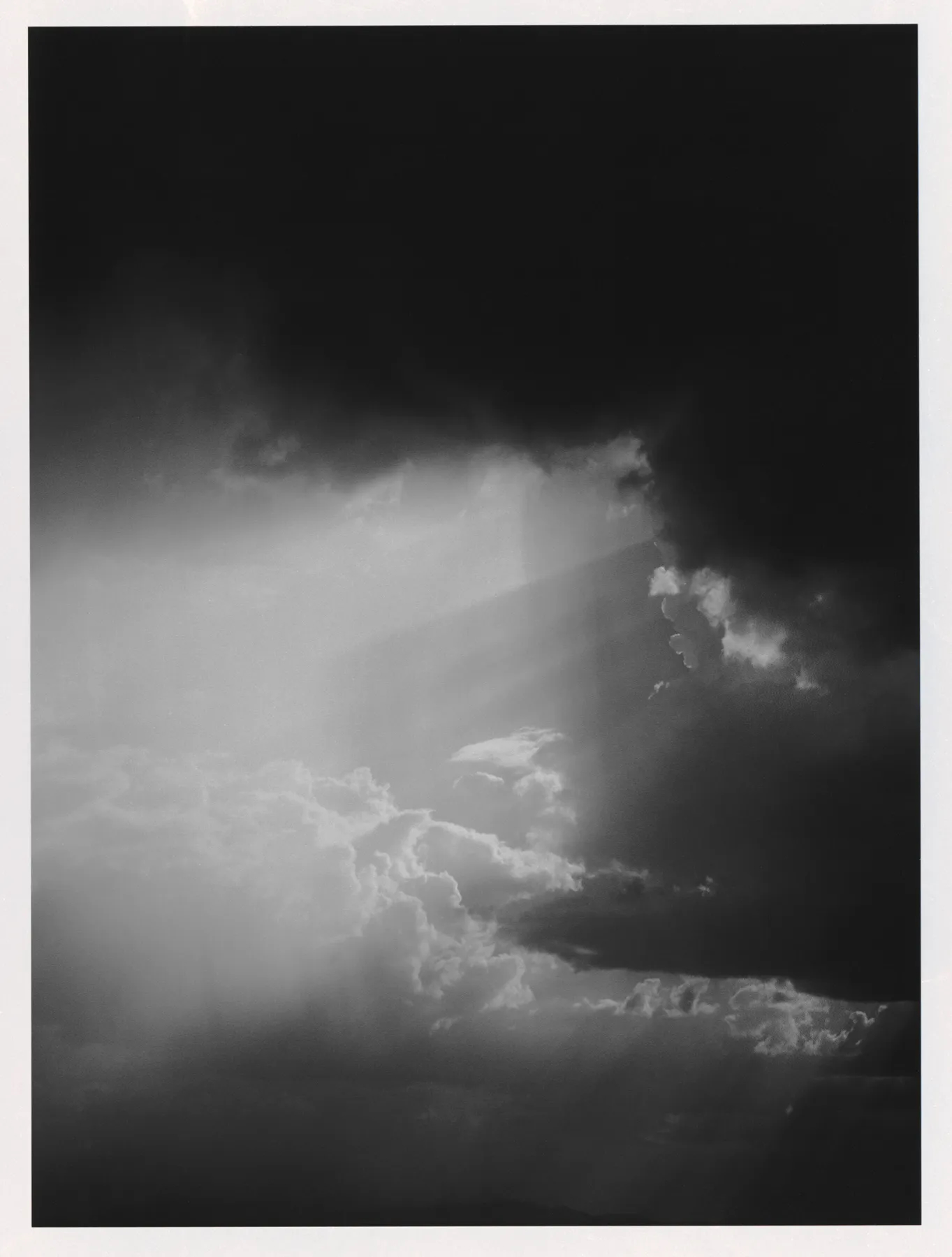
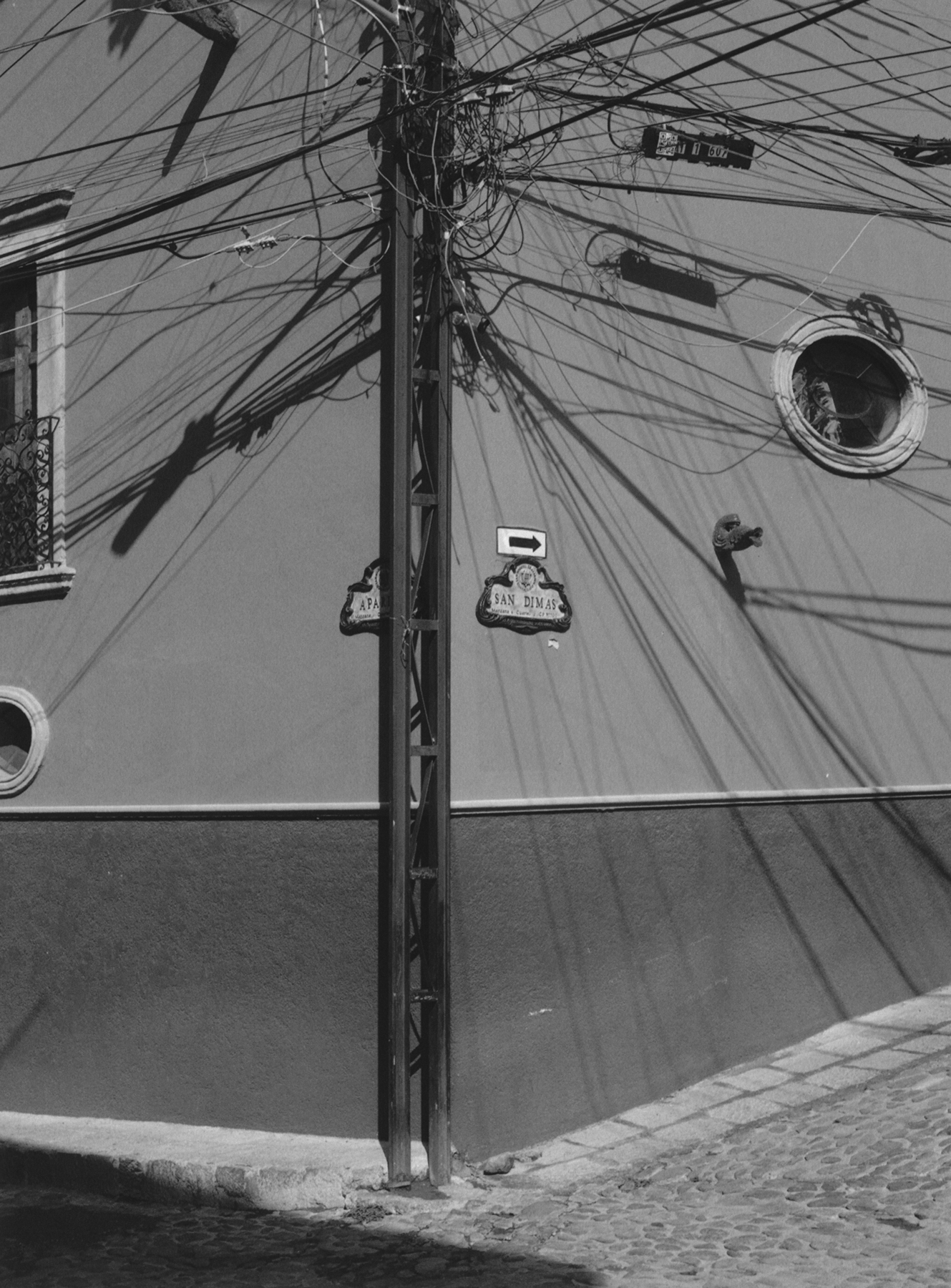


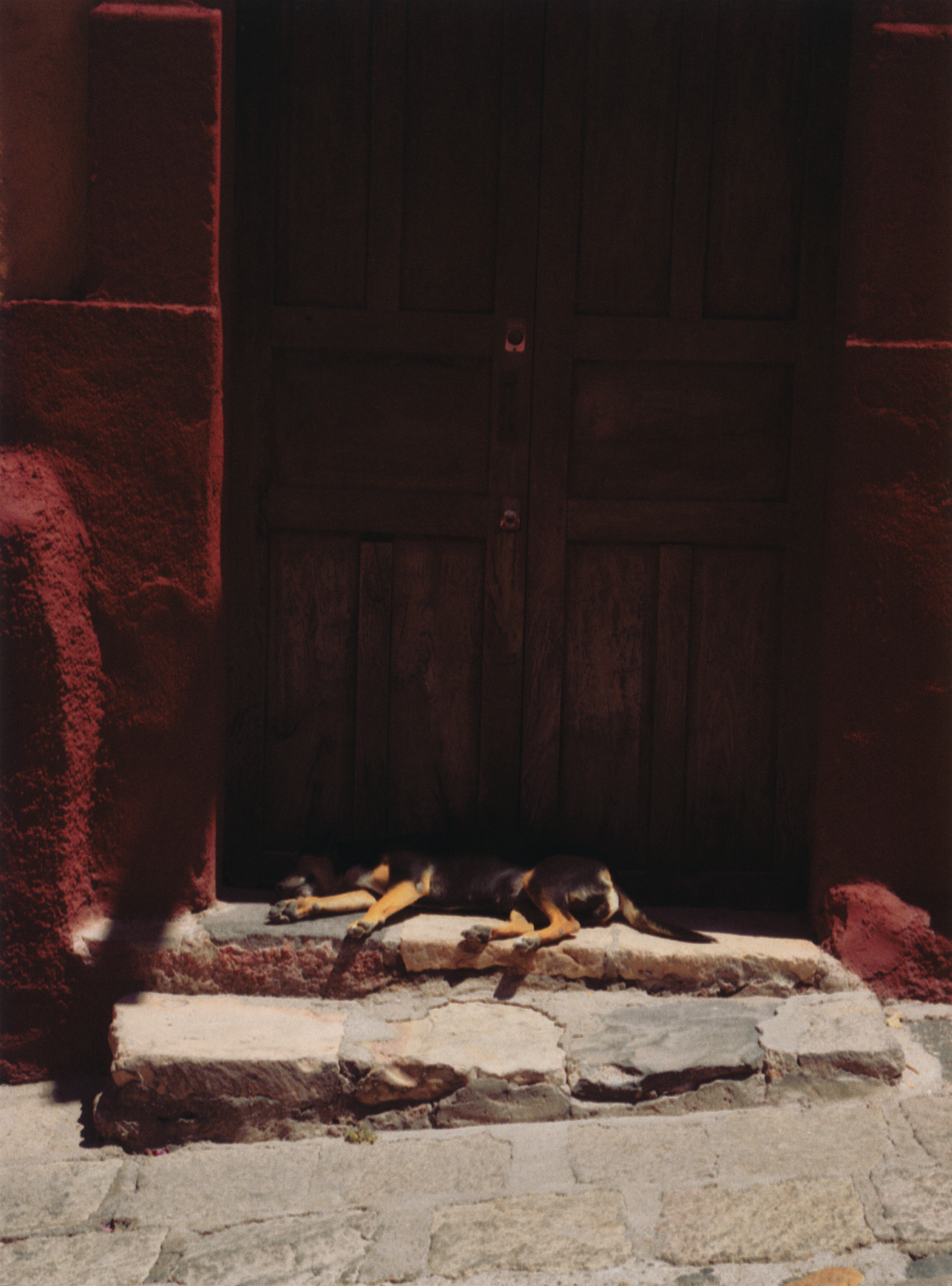
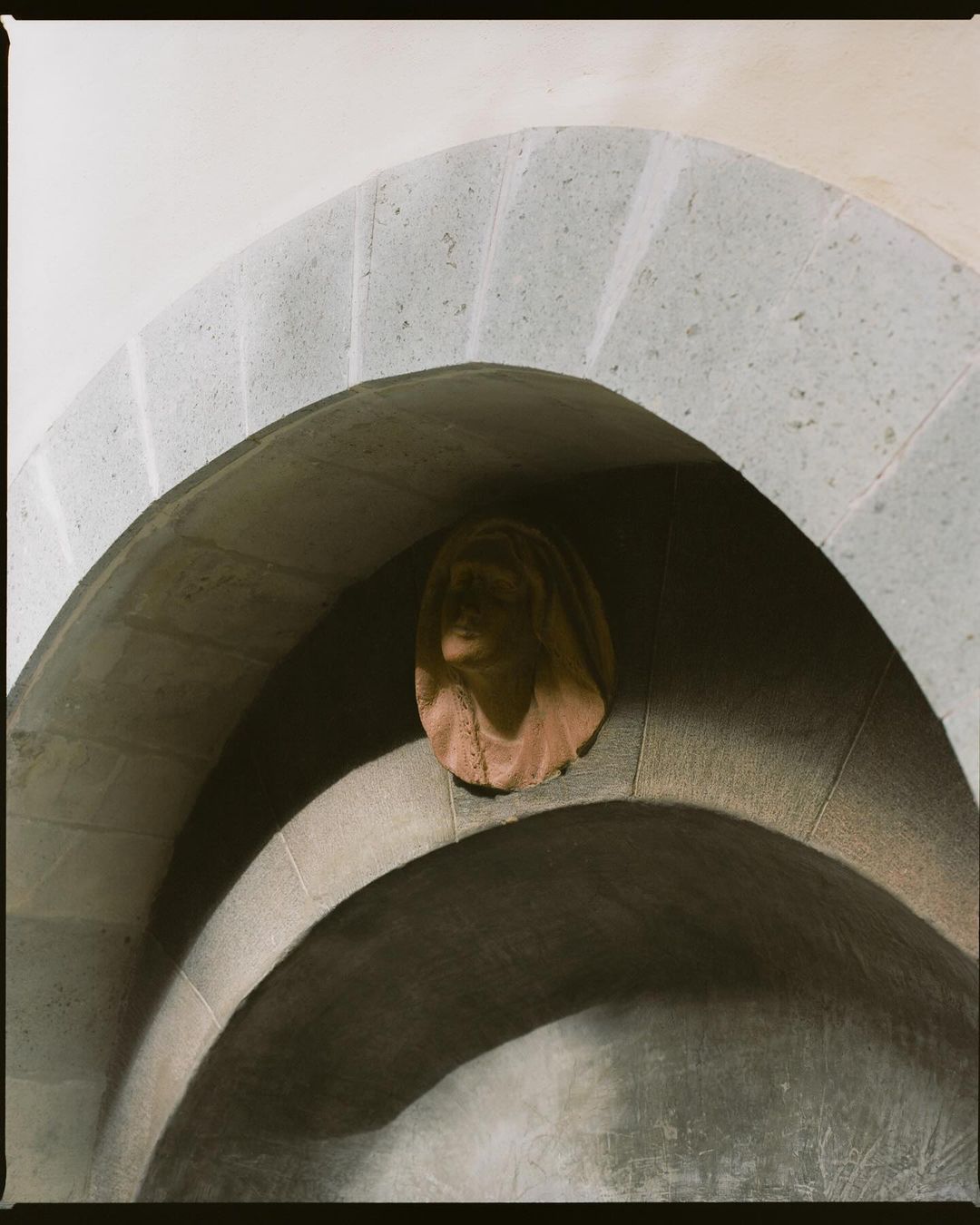

Half awake from a night flight to León and in my taxi with a blue-purple tint to the windows, the drive through the mountains precisely at sunrise was colored luridly. We drove through the dusted mountains in a day-to-night aquamarine hue. Although my eyes never adjusted, I was mostly kept awake by the blaring Top 40 radio station. It felt funny as it felt serious, this soundtrack. An hour of this and almost suddenly I was arriving at the town only before experienced as a pin on google maps.
You can feel your entrance to San Miguel. The streets vibrate like a Morse code written by the footsteps of thousands before you. I found myself in a fairy tale of a town painted with rich tones of rust, gold and rose. The cobblestone streets are narrow and almost incandescent from the heat. They present walled-in courtyard homes with epic portals standing shoulder-to-shoulder, block by block. Towering above you are the spires dedicated to Saints with totems of angels weathered by the elements. Untouched in 250 years. At this time of year the sun sat high in the sky to stand on top of buildings. The day without shadows. Can you imagine? Only the painted walls had their texture touched by the heat while I stood breathless in the streets.
![]()
For the next two weeks Sin Nombre was my home–A house designed by OHLA Studio, a practice based in San Miguel whose forte is interior and landscape design and art direction as well as furniture production with their core collection Alcocer. As a case study it had this aura of quietude. A concise color palette congruent to the choices in furniture and building materials. The facade is nondescript from the walking street with a seamless portal that opens up to an expansive ground level fortified with OHLA-designed furniture and a full wall of north-facing vertical louver windows. Symmetrically centered on the right half of the room is a stone island in the kitchen glowing from a hanging aluminum pendant much like an ancient scale set perfectly in balance. To the left is the Landin dining table with textured carved legs, seated with the lean but solid Lupita aluminum chair. Beyond was my favorite zone in the house: the sunken living room.
![]()
![]()
The built-in sofa wrapped around a blackened fireplace inset to the wall was where I spent most of my time, especially every morning ritualistically sipping on my coffee until it ran cold while I stretched and meditated. Above were two bedrooms split down the middle from a spiral staircase leading you upwards to the rooftop where you could see San Miguel in its entirety. Up there you felt like your head was in the heavens, especially on days it would storm and the thunder cracked what sounded like inside of you. What I liked about the home was similar in vein to the modernist movement in California: the outside was just as important as the indoors. When the louvered windows were open the ‘inside’ dissolved away. Having that felt luxurious and freeing.
![]()
San Miguel de Allende is a stunning city on foot. I would walk through the hills to peer down on Parroquia de San Miguel Arcángel, watching couples get engaged and mariachi bands serenading tourists while they withdrew cash from the ATM. Peppered throughout the town are fountains carved into the sides of homes displaying religious or aquatic figures above a spigot of running water. Most afternoons I would sit near the basketball courts at Parque Benito Juárez and watch those competitively play ball while stray dogs would pass me by. It was a friendly pathway for locals. I mostly noticed people in pairs. Not many were eating or wandering solo like I was. Pretty soon I associated San Miguel as a place for hedonists. The air felt romantic in a soft way: upfront but not obtuse. Noticing how others had this grip on love admittedly made me sad but not in a sense that I was afraid of. It’s a pleasant cloud to be in sometimes and should be just as accepted as happiness would be. It meant someone would greet me and attempt to have a full-fledged conversation on the street having just experienced perhaps the best day of their life, even if on the inside I was arriving on that sidewalk from a completely different plane of existence. It made me think We over-complicate things as simple and lovely as human connection. Why does it feel sinful to be blue in Eden? I spent most days alone, some days not even physically speaking at all. With me was a loud inner-dialogue with the shutter click from my RZ. You could say it was my walking of a labyrinth.
![]()
Returning home one evening I was ascending the unreasonably steep road that led me home to Sin Nombre when the streetlamps lost their power and shuttered off. I turned and noticed that the whole town and mountains beyond were dark. For the few seconds that felt like minutes I stood in the black of night and it was quiet. The power cut the drumming white noise of televisions and box fans. Quiet like the vacuum of space with no murmurs of a language I could barely understand. The only sensible vibration was the beating of my heart. I could see just about nothing. I felt invisible. Am I colorless in the dark? Finally they all see what I see, even if it is nothing at all.
Sometimes I get into this mode where I believe that taking a photograph would ruin my experience of something. Maybe it’s a belief that my image could never compare to how it feels to be in it. Was I losing confidence in my craft? Even just the etymology around photography is violence. Take. Capture. Shoot. Negative. What place does it have for grace? What can be said for the simulacra of this precious life of mine? I went days without making a single frame despite it being my sole intention for this residency. I thought about a disservice I would be providing as an outsider to imprint someone’s likeness on my film negative to advertise and promote my business. I felt the violence of photography. The taking of those moments out of thin air. But, I like the act. It feels responsive in the way that words appear on paper: Reformed with new syntaxes. Photography feels that way now. Making images is a second voice, if not a second language. I was also battling what success of seeing is as if the only means of success around photography nowadays is to share it publicly. It really was a privilege to be battling this intrapersonal debate in such a place. What a gift it is to be born with the brain and heart of an artist: born with more questions than answers.
20.9144° N, 100.7452° W - July 2023
You can feel your entrance to San Miguel. The streets vibrate like a Morse code written by the footsteps of thousands before you. I found myself in a fairy tale of a town painted with rich tones of rust, gold and rose. The cobblestone streets are narrow and almost incandescent from the heat. They present walled-in courtyard homes with epic portals standing shoulder-to-shoulder, block by block. Towering above you are the spires dedicated to Saints with totems of angels weathered by the elements. Untouched in 250 years. At this time of year the sun sat high in the sky to stand on top of buildings. The day without shadows. Can you imagine? Only the painted walls had their texture touched by the heat while I stood breathless in the streets.
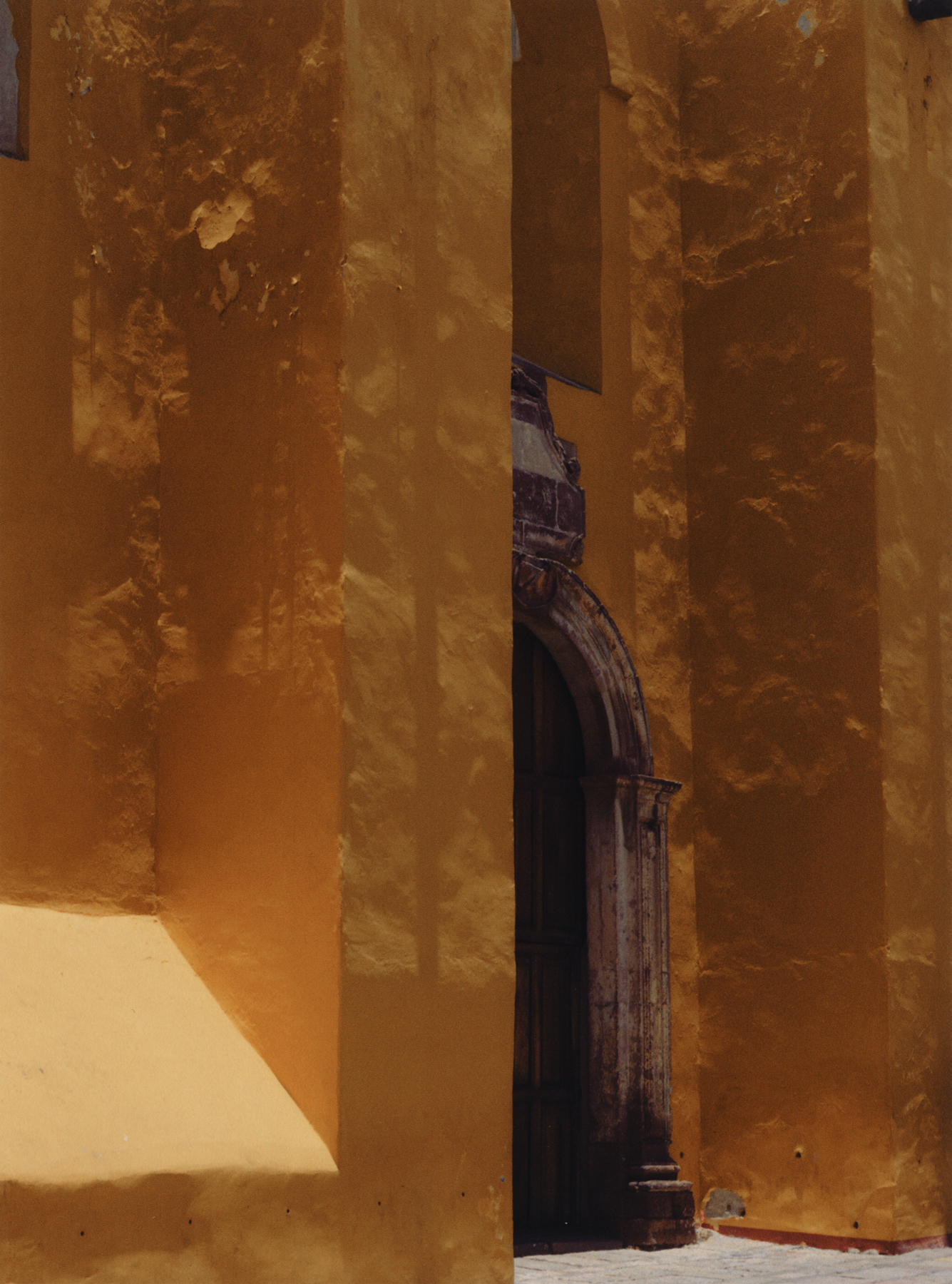
For the next two weeks Sin Nombre was my home–A house designed by OHLA Studio, a practice based in San Miguel whose forte is interior and landscape design and art direction as well as furniture production with their core collection Alcocer. As a case study it had this aura of quietude. A concise color palette congruent to the choices in furniture and building materials. The facade is nondescript from the walking street with a seamless portal that opens up to an expansive ground level fortified with OHLA-designed furniture and a full wall of north-facing vertical louver windows. Symmetrically centered on the right half of the room is a stone island in the kitchen glowing from a hanging aluminum pendant much like an ancient scale set perfectly in balance. To the left is the Landin dining table with textured carved legs, seated with the lean but solid Lupita aluminum chair. Beyond was my favorite zone in the house: the sunken living room.
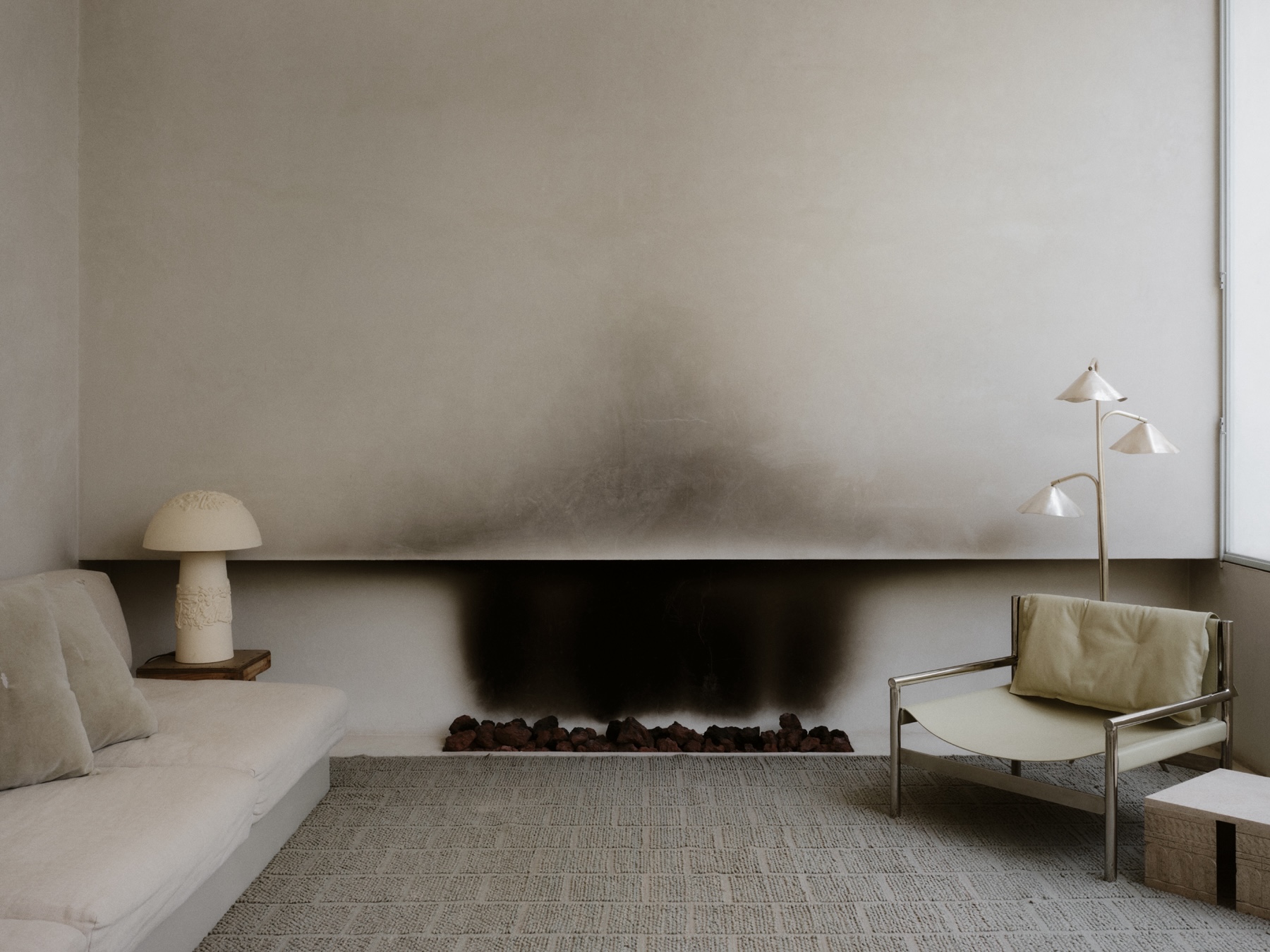

The built-in sofa wrapped around a blackened fireplace inset to the wall was where I spent most of my time, especially every morning ritualistically sipping on my coffee until it ran cold while I stretched and meditated. Above were two bedrooms split down the middle from a spiral staircase leading you upwards to the rooftop where you could see San Miguel in its entirety. Up there you felt like your head was in the heavens, especially on days it would storm and the thunder cracked what sounded like inside of you. What I liked about the home was similar in vein to the modernist movement in California: the outside was just as important as the indoors. When the louvered windows were open the ‘inside’ dissolved away. Having that felt luxurious and freeing.

San Miguel de Allende is a stunning city on foot. I would walk through the hills to peer down on Parroquia de San Miguel Arcángel, watching couples get engaged and mariachi bands serenading tourists while they withdrew cash from the ATM. Peppered throughout the town are fountains carved into the sides of homes displaying religious or aquatic figures above a spigot of running water. Most afternoons I would sit near the basketball courts at Parque Benito Juárez and watch those competitively play ball while stray dogs would pass me by. It was a friendly pathway for locals. I mostly noticed people in pairs. Not many were eating or wandering solo like I was. Pretty soon I associated San Miguel as a place for hedonists. The air felt romantic in a soft way: upfront but not obtuse. Noticing how others had this grip on love admittedly made me sad but not in a sense that I was afraid of. It’s a pleasant cloud to be in sometimes and should be just as accepted as happiness would be. It meant someone would greet me and attempt to have a full-fledged conversation on the street having just experienced perhaps the best day of their life, even if on the inside I was arriving on that sidewalk from a completely different plane of existence. It made me think We over-complicate things as simple and lovely as human connection. Why does it feel sinful to be blue in Eden? I spent most days alone, some days not even physically speaking at all. With me was a loud inner-dialogue with the shutter click from my RZ. You could say it was my walking of a labyrinth.

Returning home one evening I was ascending the unreasonably steep road that led me home to Sin Nombre when the streetlamps lost their power and shuttered off. I turned and noticed that the whole town and mountains beyond were dark. For the few seconds that felt like minutes I stood in the black of night and it was quiet. The power cut the drumming white noise of televisions and box fans. Quiet like the vacuum of space with no murmurs of a language I could barely understand. The only sensible vibration was the beating of my heart. I could see just about nothing. I felt invisible. Am I colorless in the dark? Finally they all see what I see, even if it is nothing at all.
Sometimes I get into this mode where I believe that taking a photograph would ruin my experience of something. Maybe it’s a belief that my image could never compare to how it feels to be in it. Was I losing confidence in my craft? Even just the etymology around photography is violence. Take. Capture. Shoot. Negative. What place does it have for grace? What can be said for the simulacra of this precious life of mine? I went days without making a single frame despite it being my sole intention for this residency. I thought about a disservice I would be providing as an outsider to imprint someone’s likeness on my film negative to advertise and promote my business. I felt the violence of photography. The taking of those moments out of thin air. But, I like the act. It feels responsive in the way that words appear on paper: Reformed with new syntaxes. Photography feels that way now. Making images is a second voice, if not a second language. I was also battling what success of seeing is as if the only means of success around photography nowadays is to share it publicly. It really was a privilege to be battling this intrapersonal debate in such a place. What a gift it is to be born with the brain and heart of an artist: born with more questions than answers.
20.9144° N, 100.7452° W - July 2023
